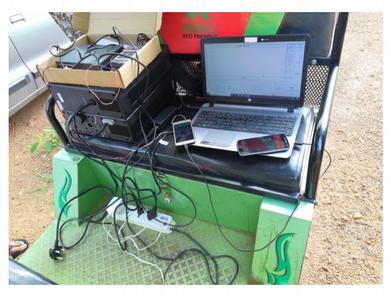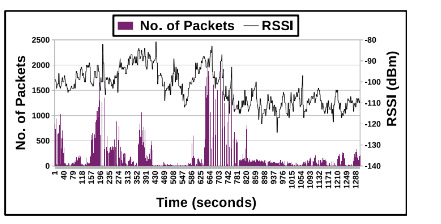An in-house measurement study reinforces that mobile phones in India often need to fallback to legacy networks to remain connected. This hampers the stability of the connection quality, which worsens with speed. In our experiment, we execute a measurement study across different cities and for different mobility scenarios to comprehend the effect of the cellular connection quality on the TCP throughput experienced by a end mobile user. We use popular mobile Internet service providers in India, such as Airtel, Reliance JIO, and Vodafone-Idea, and commercially available VoLTE enabled Android smartphones, such as Moto G5 and micromax Canvas Infinity. We have carried out these repeated measurement trials inside the IIT Kharagpur campus, and some major cities like Kolkata, Bangalore, Guwahati, etc. Fig. 1 shows the local experimental set-up inside the IIT Kharagpur campus.
 |
|---|
| Experimental Setup |
One of the outcomes of such an experiment is shown in Fig. 2.
 |
|---|
| Trajectory of Moto G5 connected to Airtel inside IIT Kharagpur campus. Associated network standards (4G, HSDPA, 3G, EDGE) highlighted using different colours |
It shows the trajectory of a Moto G5 phone associated with the Airtel network while moving inside the IIT Kharagpur campus in a slow-moving vehicle. It displays the different network technologies that the phone encounters while its service provider remains unchanged. At the same time, the RSSI also varies between -87 dBm to -126 dBm, over an area of 8.5 sqkm. The experiment incites two observations which have been found to be true in all locations where the measurements have been carried out. (i) A service provider does not guarantee a complete 4G connectivity. (ii) Even when 4G connectivity is available, the signal strength is not very high. An important takeaway from our measurement study is, the throughput experienced by a mobile phone depends on various factors, such as RSSI, the technology of the serving and interfering base-stations, load of the serving base-station, speed, etc.
Our study also involves profiling the energy consumption by smartphones. To this end, we adopt the Radio Resource Control (RRC) state machine for 4G. According to this state transition logic, in the absence of any active transmission, the network interfaces of phones are usually in the IDLE state, in which they consume low battery power. Once an active transmission ensues, the phone moves to the higher power CONNECTED state. After the transmission is over, the network interface waits in the CONNECTED state through short and long Discontinuous Reception (DRX) cycles. During this time, it consumes an intermediate energy between the IDLE and CONNECTED state. It may well be called the TAIL state. Once the tail time expires, the mobile interface returns to the IDLE state. Our experiment involved deriving the RRC state transition states for all combinations of the service providers and the mobile phones using the High Voltage Power Monitor in stationary condition.
The second phase of our measurement study included measuring the energy consumption of different video streaming applications - such as Amazon Prime, Netflix, YouTube, SonyLive, etc., while running an smartphones. An outcome of our experiment on video download is shown in Fig.3. It shows that the current protocol of video download attributes higher weightage to the playback-buffer length than the user’s instantaneous received signal strength or throughput.
 |
|---|
| Packet trace of a 360p Youtube video download with the temporal variation in the RSSI during the download |